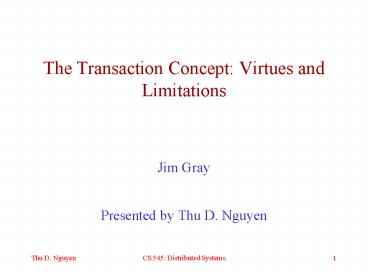The Transaction Concept: Virtues and Limitations - PowerPoint PPT Presentation
1 / 11
Title:
The Transaction Concept: Virtues and Limitations
Description:
'Oldy but Goody' This is one of the clearest explanation of the transaction concept I have ever ... It's a contract between two or more parties. that is agreed ... – PowerPoint PPT presentation
Number of Views:84
Avg rating:3.0/5.0
Title: The Transaction Concept: Virtues and Limitations
1
The Transaction Concept Virtues and Limitations
- Jim Gray
- Presented by Thu D. Nguyen
2
Oldy but Goody
- This is one of the clearest explanation of the
transaction concept I have ever seen - What is a transaction?
- Its a contract between two or more parties
- that is agreed to by all parties
- and is binding on all parties
3
Transaction
- What does it mean in computer systems?
- View system state as comprised of records and
devices with changeable values - The system contains assertions about the possible
values and allowed transformations - Think of this as really the set of laws that we
obey when negotiating a contract - We say that the system is in a consistent state
if all assertions are true - and a set of operations to read and/or transform
the state - An action seems to be either equivalent to an
operation or a set of operations
4
Transaction (contd)
- A transaction is then any set of operations that
leads from one consistent state to another - A transaction is said to have four properties
- A atomicity
- C Consistence
- I Isolation
- D Durable
- Gray does not mention I explicitly but does
discuss it when he talks about commit and abort
and locking - Anything wrong with this model?
5
Clarifying Actions
- Unprotected
- Action does not need to be undone if transaction
aborts - Action does not need to be redone if values of
affected entities (records or device) need to be
reconstructed - Protected
- Action needs to be undone if transaction aborts
- Action needs to be redone if values of affected
entities need to be reconstructed - Real
- Once done, the action cannot be undone
6
Transaction Outcomes
- Committed
- The accumulated effects of all protected and real
actions performed as part of the transaction must
persist, even in the presence of failures - Aborted
- The effects of protected and real actions
performed as part of the transaction must never
be seen by another transaction (that eventually
commits) - Real actions
- If you want real actions inside a transaction to
be unseen when that transaction aborts, you
cannot perform that action until you know that
the transaction is going to commit - What if in the middle of doing a sequence of real
actions and one of them fail?
7
Nested Transactions
- If there are lots of actions inside a single
transaction, the transaction might take too long
or the probability of conflict with another
transaction might become too high - A transaction might be thought of as comprised of
a set of nested transactions - Some nested transactions might run in parallel
- The parent transaction can commit or abort
regardless of commit or aborts of nested
transactions - Commit means that all actions of nested
transactions that committed and any of the
transaction itself will persist - If the parent aborts, all nested transactions
must abort - Results of nested transactions are not visible
outside of the parent transaction until commit of
the parent transaction
8
Hardware and Software Reliability
- Gray argues that
- People know how to build reliable hardware by
making use of redundancy - Hardware components have self-checking tests to
assure a fail-fast model - Hardware components can be duplicated to tolerate
faults - However, building fault-tolerance software on top
of this reliable hardware is HARD! - Transaction makes building fault-tolerant
software easier because it provides a clean model
to deal with failures
9
Implementation Details
- Time-domain addressing
- Basic idea keep all versions of records (and
devices) and address by name and version (logical
time) - Have system of updating time of records when read
or modified so that can know to abort or commit
transactions - Im not sure but I dont think this method is
used much anymore
10
Implementation Details
- Lock, logging, and 2-phase commit
- Logs allow undo and redo
- Locking support isolation (or serialization)
- Strict 2-phase locking prevents cascaded abort
- 2-phase commit allows all parties that
participated in a transaction to agree or
disagree at commit time
11
Limitations
- Long-lived transactions
- Deadlocks
- Block other transactions for too long
- Nested transactions
- If we allow results of committed sub-transactions
to be seen by other transactions, then atomicity
and serializability are both broken - If we dont, then we have problem with long-lived
transactions - Integration into language
- Done with various systems Argus from MIT (1985)
is one example - Java anyone?






























